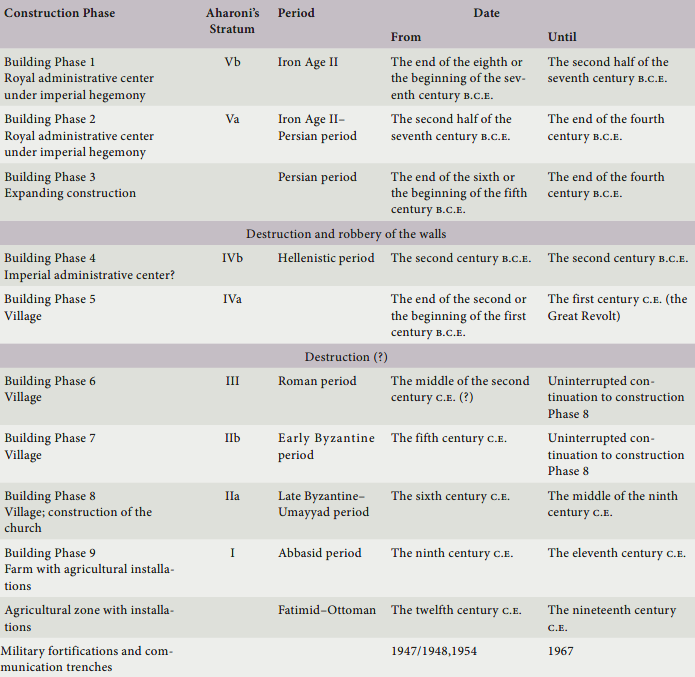Ramat Rachel
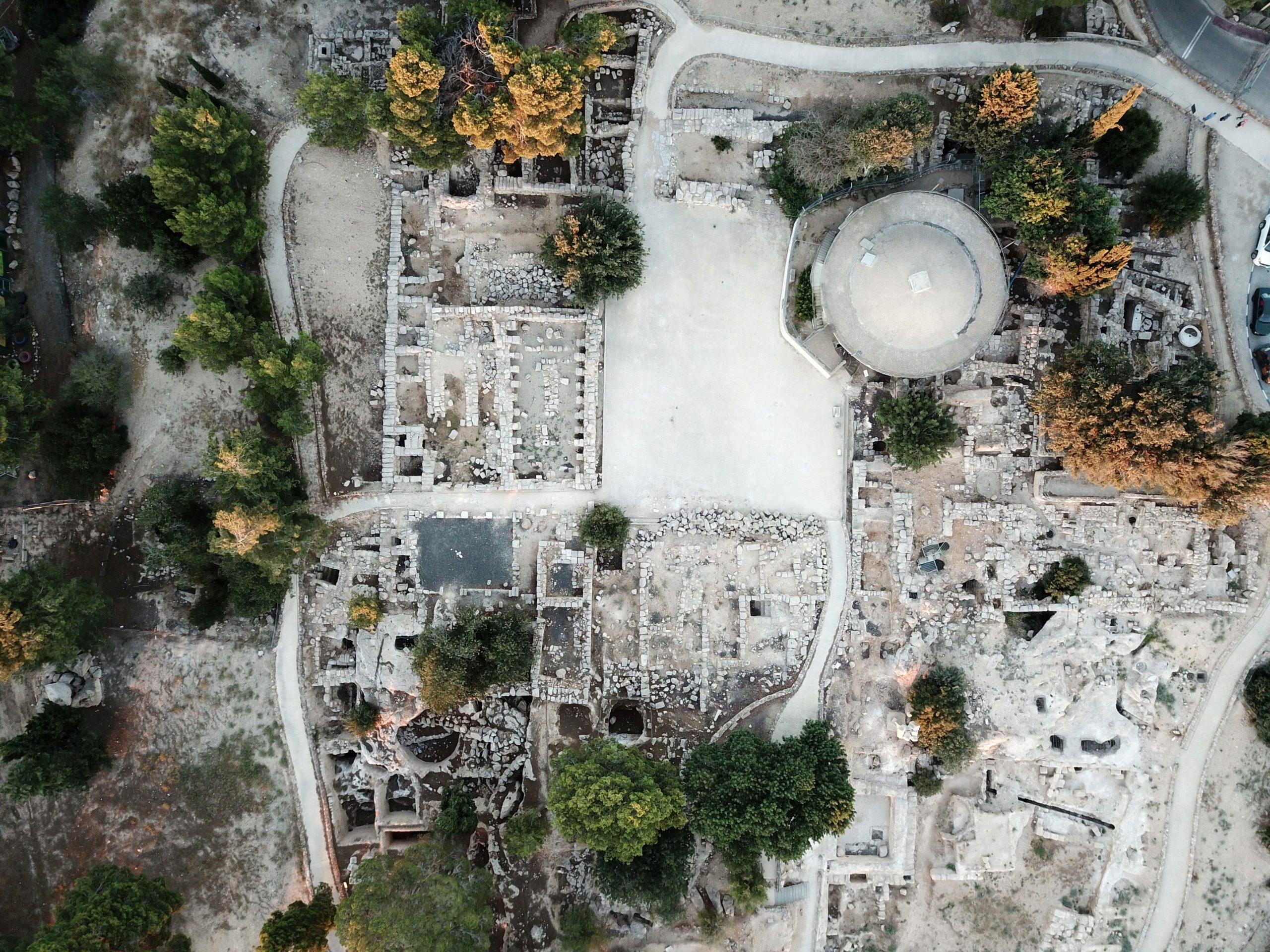 Aerial View of Ramat Rachel
Aerial View of Ramat RachelClick on Image for high resolution magnifiable image
Used with permission from Biblewalks.com
| Transliterated Name | Source | Name |
|---|---|---|
| Ramat Rachel | Hebrew | רָמַת רָחֵל |
| Khirbet es-Sallah | Arabic | كهيربيت يسءساللاه |
| Bethofor | Byzantine Name | |
| Pathofor | Variant of Byzantine Name | |
| Betheabra | Variant of Byzantine Name | |
| Kathisma | Incorrect Byzantine Name | |
| MMST | Theorized Ancient Name |
The mound of Ramat Rahel is located on a prominent hill midway between the Old City of Jerusalem and Bethlehem (Yohanan Aharoni in Stern et al, 1993). Numerous excavations carried out on the mound have uncovered remains from the 8th century BCE until the present punctuated by possible destructions - at the end of the 4th century BCE, at the end of the first Jewish War against Rome in ca. 70 CE, and after a mid 8th century CE earthquake. The town appears to have grown during the Byzantine period followed by an Early Arab period built upon the ruins of Byzantine strata. The Byzantine town was originally thought to have been named Kathisma after a story that it was the site where Mary rested on her way to Bethlehem but the discovery of what appears to be the authentic Kathisma Church nearby has dis-affirmed that. Excavations by Aharoni in the 1950's appear to have suffered from organizational problems, may have been hindered by geopolitical tensions of the time, and produced some faulty conclusions (e.g. that the Kathisma Church was located there and that the Roman 10th Legion was stationed there) but the stratigraphic framework appears to be approximately correct and useful. More recent excavations by Oded Lipschitz and Manfed Oeming appear to have resolved a number of earlier problems.
The mound of Ramat Rahel is situated on a prominent hill (818 m above sea level) almost midway between the Old City of Jerusalem and Bethlehem. The site is occupied today by Kibbutz Ramat Rahel (map reference 1708.1275). The ancient name of the site has not been preserved, but about 400 m west of the mound is the well of Bir Qadismu, which preserves the name of the Byzantine Kathisma (Καθισμα) Church.
Excavations carried out on the mound have established that the first settlement was founded in the ninth or eighth century BCE, when a royal stronghold was constructed surrounded by gardens and farmhouses. This was followed by a fortress with a magnificent palace at its center, erected by one of the later kings of Judah. The many seal impressions stamped Yehud (Judah) found on the site indicate that it was an administrative center during the Persian period. At the end of the Second Temple period, an ordinary settlement containing a large number of workshops occupied the site, which shared the fate of Jerusalem when that city was destroyed (70 CE). The Tenth Roman Legion was later stationed here. According to Cyril of Scythopolis (Vita Theodorii 1), the Kathisma Church and monastery were built on the site in the middle of the fifth century CE. A poorly constructed Arab settlement here in the eighth century CE was the last before the modern period.
The excavations did not confirm B. Mazar's proposal to identify the site with Netophah since, according to the Bible, that city existed in the days of David (2 Sam. 23:28 and passim), and no remains of so early a period were uncovered there. The results did prompt Y. Aharoni to suggest that the site be identified with Beth-Haccherem, an assumption most scholars share. Beth-Haccherem is first mentioned in a roster of Judean cities in the Bethlehem district that cannot be earlier than the ninth century BCE (addition of the Septuagint to Jos. 15:59a, Καρεμ). In the time of Jeremiah, fire signals to warn Jerusalem were sent up from Beth-Haccherem (Jer. 6:1). In the days of Nehemiah, Beth-Haccherem was a district center (Neh. 3:14). From the Mishnah (Mid. 3, 4) and from the Judean Desert scrolls (Genesis Apocryphon XXII, 14; Copper Scroll X, 5), it is learned that Beth-Haccherem and the Valley of Beth-Haccherem were very close to Jerusalem. All these sources are consistent with the conclusions arrived at in the excavations. It can be assumed that the ancient royal citadel was built on the site of the king's vineyards: hence the name Beth-Haccherem ("house of the vineyard"). The later citadel and the palace, which are described in Jeremiah (22:13-19), were probably built by Jehoiakim, son of Josiah (608-597 BCE). The window balustrades found in the excavations (see below, stratum VA) are apparently those mentioned by Jeremiah 22. Y. Yadin suggested identifying the site with the house Athaliah built for the god Ba'al in Jerusalem (2 Kg. II: 18). The church and the monastery that were built on the site in the Byzantine period were called by the name of Kathisma, "seat," following a Christian tradition, reported in the proto-Evangelion of James (17:2-3), according to which Mary, mother of Jesus, rested here on her way to Bethlehem.
In 1931, a burial cave dating from the end of the Second Temple period was discovered south of the mound. It was excavated by B. Mazar and M. Stekelis on behalf of the Palestine Exploration Society. Excavations on the mound itself were undertaken in the summer of 1954 under the direction of Y. Aharani, on behalf of the Israel Department of Antiquities and the Israel Exploration Society. Five seasons of campaigns were conducted at the site. In 1959, the Hebrew University of Jerusalem in conjunction with the above named institutions, sponsored the excavations; in the years 1960, 1961, and 1962 they were under the joint sponsorship of the three Israeli institutions and the University of Rome.
In 1984, excavations were carried out at Ramat Rahel under the direction of G. Barkay, on behalf of the Institute of Archaeology at Tel Aviv University, the Israel Exploration Society, and the Institute of Holyland Studies on Mount Zion. The excavations were concentrated in two trenches cut in the northern and the western slopes of the mound. Under the earliest floors of the citadel pottery from the eighth century BCE was found, indicating the period in which, according to the excavator, the first Iron Age buildings were erected. In Barkay's opinion, there was a city here that included a palace built by Hezekiah. He suggests identifying the site with Mmst, one of the four place names mentioned in the lamelekh stamps.
- Fig. 1 - Location Map
from Aharoni (1956)
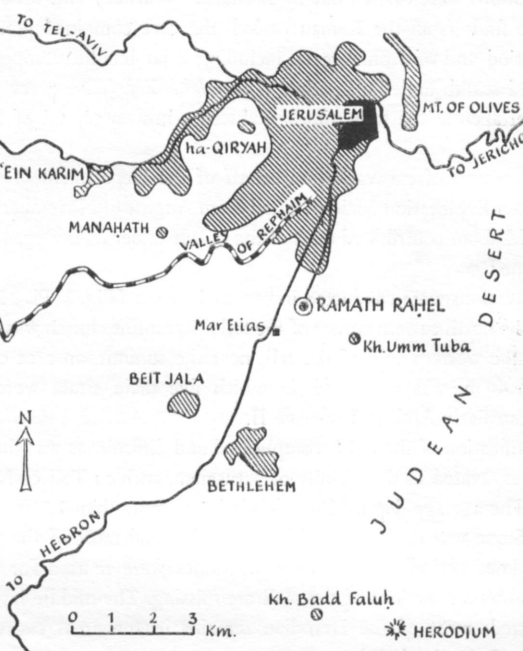
 Figure 1
Figure 1
Ramath Rahel and its vicinity
(Drawn by M. Seydewitz-Karmon)
Aharoni (1956) - Fig. 1 - Location Map
from Lipschitz et al (2011)
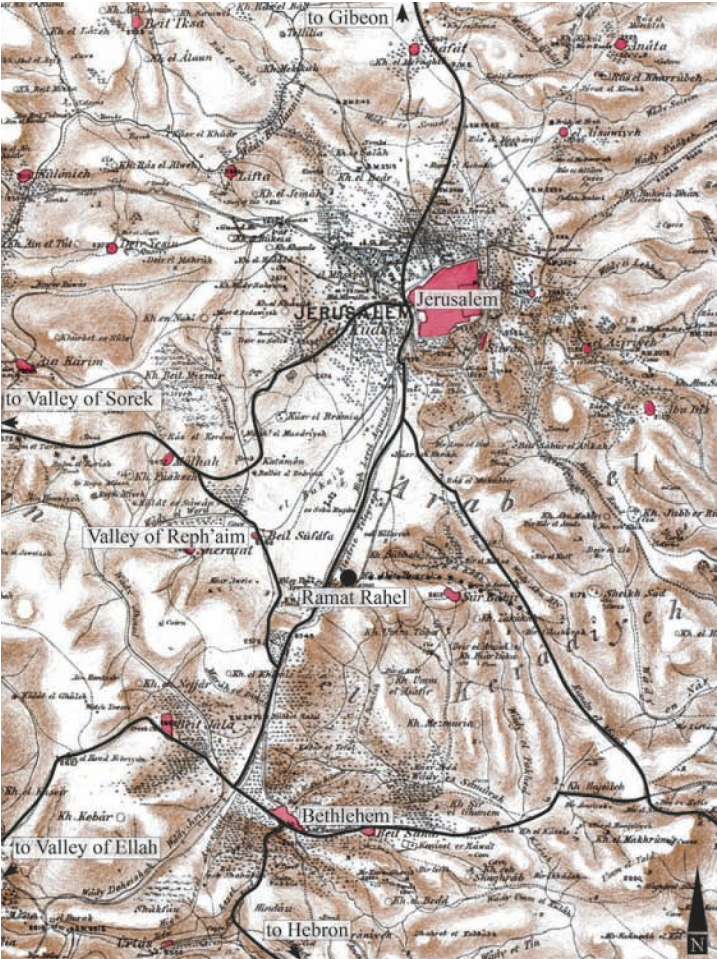
 Figure 1
Figure 1
Map of Ramat Raḥel and its vicinity, based on a map prepared by the Palestine Exploration Fund
(Adapted by Ido Koch)
Lipschitz et al (2011) - Fig. 1 - Location Map
from Avner (2016)
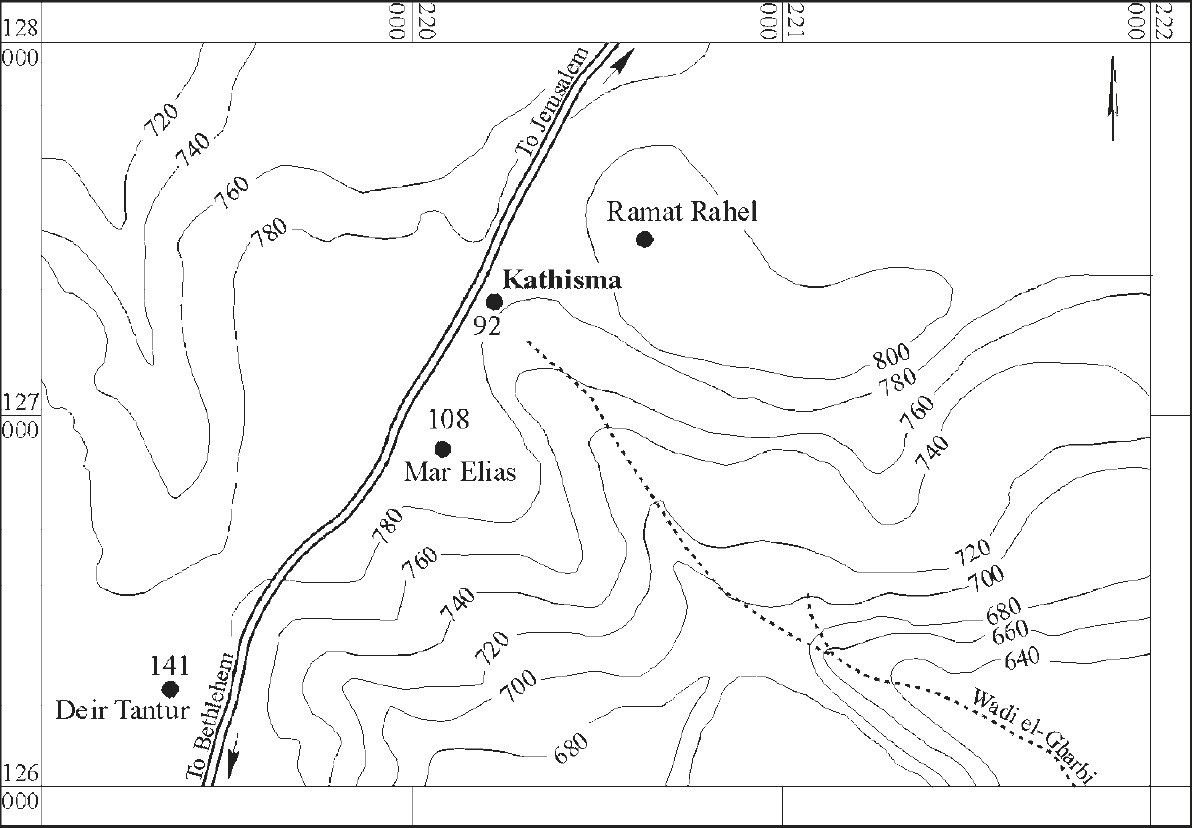
 Figure 1.1
Figure 1.1
Location Map
Avner (2016) - Fig. 9 - Topographic Map
of the Ramat Raḥel hill prior to the First Building Phase from Lipschitz et al (2011)
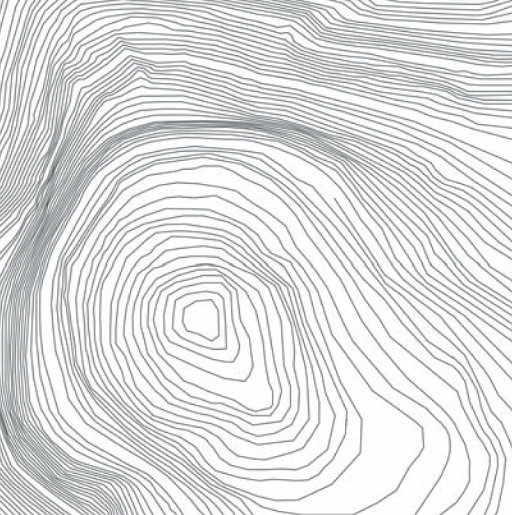
 Figure 9
Figure 9
The Ramat Raḥel hill prior to the First Building Phase
(Prepared by Nirit Kedem)
Lipschitz et al (2011)
- Ramat Rachel in Google Earth
- Ramat Rachel on govmap.gov.il
- Annotated Aerial View of
Ramat Rachel and surroundings from Biblewalks.com

 Annotated Aerial View of Ramat Rachel and surroundings
Annotated Aerial View of Ramat Rachel and surroundings
Used with permission from Biblewalks.com - Aerial View of Ramat Rachel
from Biblewalks.com

 Aerial View of Ramat Rachel
Aerial View of Ramat Rachel
Click on Image for high resolution magnifiable image
Used with permission from Biblewalks.com
- Fig. 4 - Excavation areas of
Aharoni (1954-1962) from Lipschitz et al (2011)

 Figure 4
Figure 4
The areas excavated by Aharoni from 1954 until 1962
Illustration prepared by Benjamin Arubas and adapted by Ido Koch
Lipschitz et al (2011) - Fig. 3.1 - The grid laid
by Aharoni in 1954 from Aharoni (1962 - 1964)
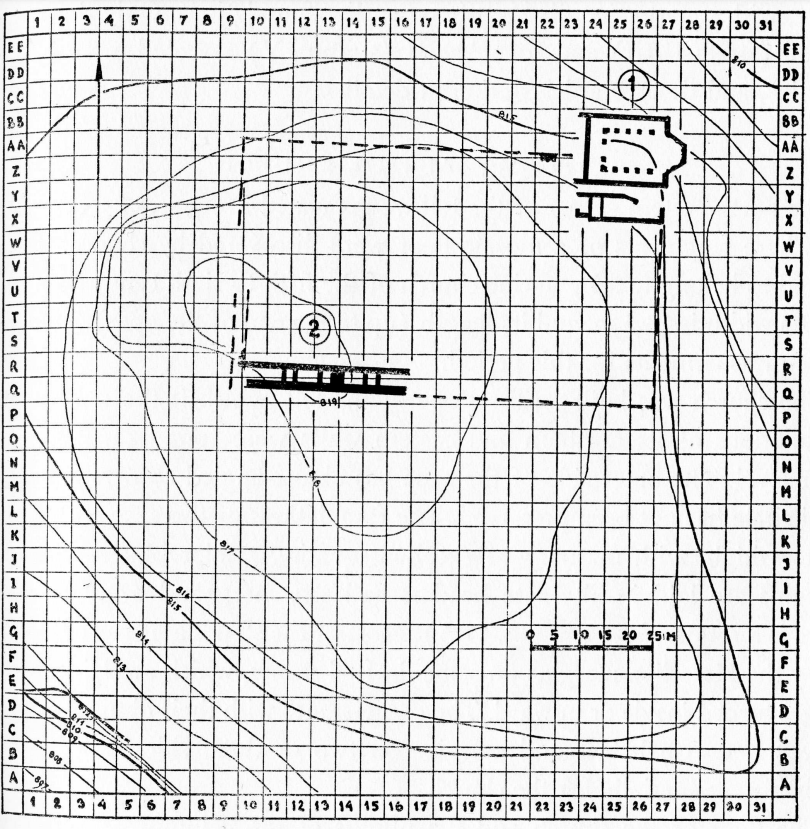
 Figure 3.1
Figure 3.1
The grid laid by Aharoni in 1954
Aharoni (1962 - 1964) - Fig. 3.2 - Aharoni’s excavations
by season, as suggested by Gadot from Aharoni (1962 - 1964)

 Figure 3.2
Figure 3.2
Aharoni’s excavations by season, as suggested by Gadot
Aharoni (1962 - 1964)
- Fig. 4 - Excavation areas of
Aharoni (1954-1962) from Lipschitz et al (2011)

 Figure 4
Figure 4
The areas excavated by Aharoni from 1954 until 1962
Illustration prepared by Benjamin Arubas and adapted by Ido Koch
Lipschitz et al (2011) - Fig. 3.1 - The grid laid
by Aharoni in 1954 from Aharoni (1962 - 1964)

 Figure 3.1
Figure 3.1
The grid laid by Aharoni in 1954
Aharoni (1962 - 1964) - Fig. 3.2 - Aharoni’s excavations
by season, as suggested by Gadot from Aharoni (1962 - 1964)

 Figure 3.2
Figure 3.2
Aharoni’s excavations by season, as suggested by Gadot
Aharoni (1962 - 1964)
- Fig. 8 - Excavation areas of
the Renewed Expedition to Ramat Rahel from Lipschitz et al (2011)

 Figure 8
Figure 8
Excavation areas of the Renewed Expedition to Ramat Rahel. Photo by Sky-View, adapted by Ido Koch
Lipschitz et al (2011) - Fig. 10 - Plan of the
Ramat Rahel edifice in Building Phases 1–3 from Lipschitz et al (2011)

 Figure 10
Figure 10
The plan of the Ramat Raḥel edifice in Building Phases 1–3
(Prepared by Benjamin Arubas)
Lipschitz et al (2011) - Fig. 6 - Plan of the
Roman and Byzantine buildings from Soennecken (2006)

 Figure 6
Figure 6
plan of Roman and Byzantine buildings
Soennecken (2006) - Fig. 7 - Plan of the
church and adjoining room from Soennecken (2006)

 Figure 7
Figure 7
plan of the church and adjoining rooms
Soennecken (2006)
- Fig. 8 - Excavation areas of
the Renewed Expedition to Ramat Rahel from Lipschitz et al (2011)

 Figure 8
Figure 8
Excavation areas of the Renewed Expedition to Ramat Rahel. Photo by Sky-View, adapted by Ido Koch
Lipschitz et al (2011) - Fig. 10 - Plan of the
Ramat Rahel edifice in Building Phases 1–3 from Lipschitz et al (2011)

 Figure 10
Figure 10
The plan of the Ramat Raḥel edifice in Building Phases 1–3
(Prepared by Benjamin Arubas)
Lipschitz et al (2011) - Fig. 6 - Plan of the
Roman and Byzantine buildings from Soennecken (2006)

 Figure 6
Figure 6
plan of Roman and Byzantine buildings
Soennecken (2006) - Fig. 7 - Plan of the
church and adjoining room from Soennecken (2006)

 Figure 7
Figure 7
plan of the church and adjoining rooms
Soennecken (2006)
As at other hilly archaeological sites, differentiating between strata at Ramat Rahel has been quite difficult. The majority of remains were found at a depth of less than 1.5 m, most building materials were reused, and the lime furnaces of later periods caused the destruction and disappearance of many of the earlier remains. The generally accepted view, however, is that there are five main strata at the site
- broad stratigraphic classification for the entire site
- from Lipschitz et al (2011)
| Aharoni's Stratum |
Period | Start Date (centuries) |
End Date (centuries) |
Construction Phase |
|---|---|---|---|---|
| Vb | Iron Age II | end 8th or beginning 7th BCE | 2nd half of 7th BCE | Building Phase 1 Royal Administrative Center under Imperial hegemony |
| Va | Iron Age II- Persian |
2nd half of 7th BCE | end of 4th BCE | Building Phase 2 Royal Administrative Center under Imperial hegemony |
| Persian | end 6th BCE or begin 5th BCE | end of 4th BCE | Building Phase 3 Expanding construction |
|
| Destruction and robbery of the walls | ||||
| IVb | Hellenistic | 2nd BCE | 2nd BCE | Building Phase 4 Imperial Administrative Center ? |
| IVa | end 2nd or begin 1st BCE | 1st CE The Great Revolt |
Building Phase 5 Village |
|
| Destruction ? | ||||
| III | Roman | middle 2nd CE ? | Uninterrupted continuation to construction Phase 8 |
Building Phase 6 Village |
| IIa | Early Byzantine | 5th CE | Uninterrupted continuation to construction Phase 8 |
Building Phase 7 Village |
| IIb | Late Byzantine- Umayyad |
6th CE | middle 9th CE | Building Phase 8 Village; construction of the church |
| I | Abbasid | 9th CE | 11th CE | Building Phase 9 Farm with agricultural installations |
| Fatimid- Ottoman |
12th CE | 19th CE | Agricultural Zone with installations | |
| 1947/1948,1954 CE | 1967 CE | Military fortifications and communication trenches |
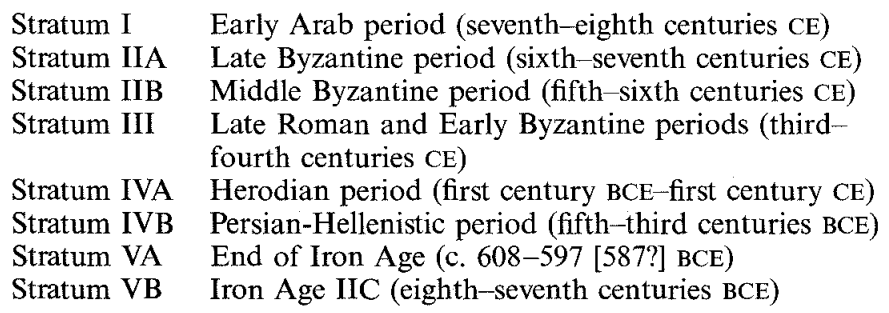 Stratigraphy of Ramat Rachel
Stratigraphy of Ramat RachelStern et al (1993 v. 4)
Lipschitz et al (2011) found potential evidence of mid 8th century seismic destruction as described below:
In the eighth century C.E., under Umayyad rule, there is clear evidence of collapse and conflagration in diverse areas of the site: the northern wall of the church collapsed, there are significant signs of various parts of Byzantine buildings giving way, and Aharoni notes indications of burning on the mosaic floor of the church. This destruction scene hints at the sudden end of the settlement, a destruction from which it never seems to have recovered - at least not as a Christian settlement. It is possible that this termination was the result of an earthquake that took place on 18 January 749 C.E.
In The Tel Aviv - Heidelberg Joint Project - The 2006 and 2007 seasons at Ramat Rahel mention is made of a 10th-11th century collapse in Area D1
A massive stone collapse had covered the floors of the different architectural units. The many broken pottery vessels date the collapse of the building to the Abbasid period [8th-10th centuries CE] or to the beginning of the Fatimid period (10th–11th century CE)
| Effect | Location | Image(s) | Description |
|---|---|---|---|
| Collapsed Walls and Fire | diverse areas of the site
 Figure 6
Figure 6plan of Roman and Byzantine buildings Soennecken (2006) |
collapse and conflagration in diverse areas of the site- Lipschitz et al (2011) |
|
| Collapsed Walls | various parts of Byzantine buildings
 Figure 6
Figure 6plan of Roman and Byzantine buildings Soennecken (2006) |
there are significant signs of various parts of Byzantine buildings giving way- Lipschitz et al (2011) |
|
| Collapsed Walls | northern wall of the church
 Figure 6
Figure 6plan of Roman and Byzantine buildings Soennecken (2006) 
 Figure 7
Figure 7plan of the church and adjoining rooms Soennecken (2006) |
the northern wall of the church collapsed- Lipschitz et al (2011) |
|
| Fire | mosaic floor of the church
 Figure 6
Figure 6plan of Roman and Byzantine buildings Soennecken (2006) 
 Figure 7
Figure 7plan of the church and adjoining rooms Soennecken (2006) |
Aharoni notes indications of burning on the mosaic floor of the church- Lipschitz et al (2011) |
| Effect | Location | Image(s) | Description |
|---|---|---|---|
| Collapsed Walls and Stone Tumble | Area D1
 Figure 8
Figure 8Excavation areas of the Renewed Expedition to Ramat Rahel. Photo by Sky-View, adapted by Ido Koch Lipschitz et al (2011) |
A massive stone collapse had covered the floors of the different architectural units- The Tel Aviv - Heidelberg Joint Project - The 2006 and 2007 seasons at Ramat Rahel |
|
| Broken Pottery | Area D1
 Figure 8
Figure 8Excavation areas of the Renewed Expedition to Ramat Rahel. Photo by Sky-View, adapted by Ido Koch Lipschitz et al (2011) |
many broken pottery vessels- The Tel Aviv - Heidelberg Joint Project - The 2006 and 2007 seasons at Ramat Rahel |
- Modified by JW from Fig. 6 of Soennecken (2006)
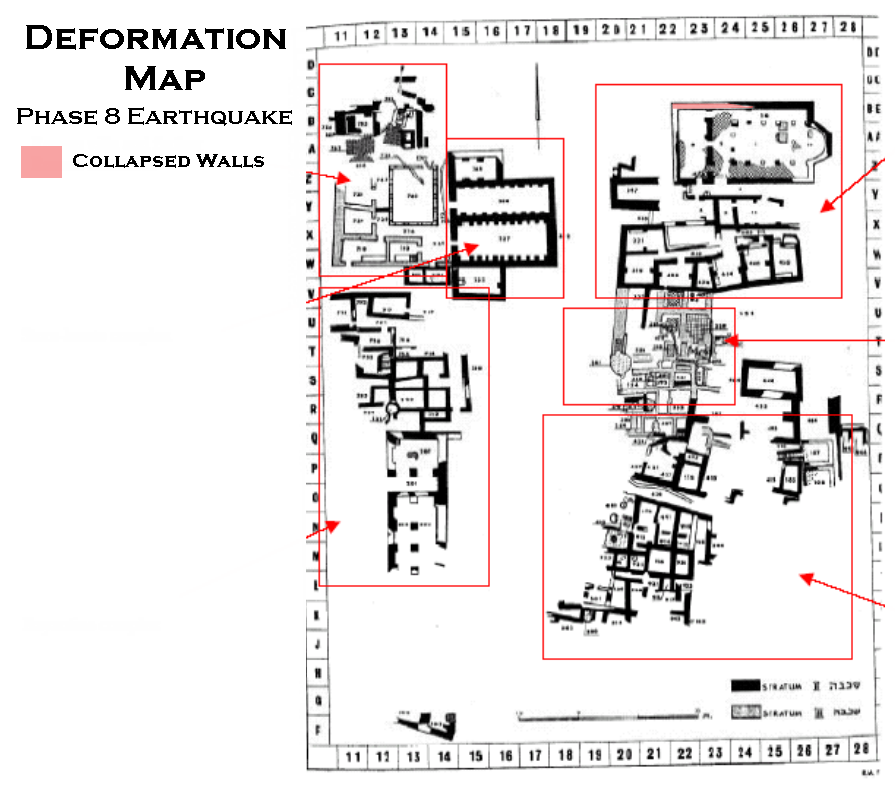 Deformation Map
Deformation Mapmodified by JW from Fig. 6 of Soennecken (2006)
- Earthquake Archeological Effects chart
of Rodríguez-Pascua et al (2013: 221-224)

 Earthquake Archeological Effects (EAE)
Earthquake Archeological Effects (EAE)
Rodríguez-Pascua et al (2013: 221-224)
| Effect | Location | Image(s) | Description | Intensity |
|---|---|---|---|---|
| Collapsed Walls and Fire | diverse areas of the site
 Figure 6
Figure 6plan of Roman and Byzantine buildings Soennecken (2006) |
collapse and conflagration in diverse areas of the site- Lipschitz et al (2011) |
VIII + | |
| Collapsed Walls | various parts of Byzantine buildings
 Figure 6
Figure 6plan of Roman and Byzantine buildings Soennecken (2006) |
there are significant signs of various parts of Byzantine buildings giving way- Lipschitz et al (2011) |
VIII + | |
| Collapsed Walls | northern wall of the church
 Figure 6
Figure 6plan of Roman and Byzantine buildings Soennecken (2006) 
 Figure 7
Figure 7plan of the church and adjoining rooms Soennecken (2006) |
the northern wall of the church collapsed- Lipschitz et al (2011) |
VIII + |
- Earthquake Archeological Effects chart
of Rodríguez-Pascua et al (2013: 221-224)

 Earthquake Archeological Effects (EAE)
Earthquake Archeological Effects (EAE)
Rodríguez-Pascua et al (2013: 221-224)
| Effect | Location | Image(s) | Description | Intensity |
|---|---|---|---|---|
| Collapsed Walls and Stone Tumble | Area D1
 Figure 8
Figure 8Excavation areas of the Renewed Expedition to Ramat Rahel. Photo by Sky-View, adapted by Ido Koch Lipschitz et al (2011) |
A massive stone collapse had covered the floors of the different architectural units- The Tel Aviv - Heidelberg Joint Project - The 2006 and 2007 seasons at Ramat Rahel |
VIII + | |
| Broken Pottery | Area D1
 Figure 8
Figure 8Excavation areas of the Renewed Expedition to Ramat Rahel. Photo by Sky-View, adapted by Ido Koch Lipschitz et al (2011) |
many broken pottery vessels- The Tel Aviv - Heidelberg Joint Project - The 2006 and 2007 seasons at Ramat Rahel |
VII + |
AHARONI, Y. (1956). Excavations at Ramath Raḥel, 1954: Preliminary Report. Israel Exploration Journal, 6(2), 102–111.
AHARONI, Y. (1956). Excavations at Ramath Raḥel, 1954: Preliminary Report. Israel Exploration Journal, 6(3), 137–157.
Aharoni, Y., et al. (1964). Excavations at Ramat Rahel, seasons 1961 and 1962. Roma, Centro die studi semitici.
A short guide to the excavations at Ramal Rahel (1955) - can be borrowed with a free account from archive.org
Lipschits, Oded, Manfred Oeming, Yuval Gadot, Benjamin Arubas and Gilad Cinamon 2006
Ramat Rahel – 2005 Hadashot Arkheologiyot Volume 118 Year 2006
Lipschits, Oded, M. Oeming, Y. Gadot, B. Arubas and G. Cinamon
2006 Ramat Rahal 2005. Israel Exploration Journal 56: 227–235.
Lipschits, Oded, M. Oeming, Y. Gadot and B. Arubas 2009
The 2006 and 2007 Excavation Seasons in Ramat Rahel. Israel Exploration Journal 59: 1-20
Lipschits, Oded,, et al. (2011).
"PALACE AND VILLAGE, PARADISE AND OBLIVION: Unraveling the Riddles of Ramat Rahel." Near Eastern Archaeology 74(1): 1-49.
Reich, Ronny. "Palaces and Residencies in the Iron Age." In The Architecture of Ancient Israel: From the Prehistoric to the Persian Periods,
edited by Aharon Kempinski and Ronny Reich, pp. 202-222. Jerusalem, 1992.
Shiloh, Yigal. The Proto-Aeolic Capital and Israelite Ashlar Masonry.
Qedem, vol. 11. Jerusalem, 1979. - can be borrowed with a free account from archive.org
Geva, Shulamit (1981). The Painted Sherd of Ramat Raḥel. Israel Exploration Journal, 31(3/4), 186–189.
Soennecken, Katja 2006, Ramat Rachel in the Byzantine Period (Masters Thesis)
Stern, Ephraim. Material Culture of the Land of the Bible in the Persian Period, 338-332 B.C. Warminster, 1982.
Stern, Ephraim. "The Phoenician Architectural Elements in Palestine
during the Late Iron Age and Persian Period." In The Architecture of
Ancient Israel: From the Prehistoric to the Persian Periods, edited by
Aharon Kempinski and Ronny Reich, pp. 302-309. Jerusalem, 1992.
Sulimani, G. and Barzel, V. (2008) Ramat Rahel Hadashot Arkheologiyot v. 120
Yadin, Yigael. "The 'House of Ba'al of Ahab and Jezebel in Samaria,
and That of Athalia in Judah. " In Archaeology in the Levant: Essays
for Kathleen Kenyan, edited by P. R. S. Moorey and Peter J. Parr,
p p . 127-135. Warminster, 1978.
Aharoni, Yohanan. Excavations at Ramat Rahel. 2 vols. Rome , 1962 - 1964.
Lipschitz, O., Gadot, Y., Freud, L., Aharoni, Y. (2016). Ramat-Raḥel III: Final Publication of Yohanan Aharoni's Excavations (1954, 1959-1962).
Israel: Emery and Claire Yass Publications in Archaeology, Tel Aviv University.
Lipschits, O., et al. (2020). Ramat Raḥel IV
The Renewed Excavations by the Tel Aviv–Heidelberg Expedition (2005–2010): Stratigraphy and Architecture, Penn State University Press.
Lipschits, O., Freud, L., Oeming, M., Gadot, Y. (2021). Ramat Raḥel VI: The Renewed Excavations by the Tel Aviv-Heidelberg Expedition (2005-2010) : the Babylonian-Persian Pit.
United States: Pennsylvania State University Press.
|
E. Stern Y.
Yadin O. Lipschits
and Y. Gadot
O. Lipschits, M. Oeming,
Y. Gadot and B. Arubas O. Lipschits,
O.Sergi and I. Koch
|
Y. Aharoni et al., Excavations at RamaJ Rahe/1: Seasons 1959 and 1960, Rome 1962; id., Excavations at Ramat Rahel 2: Seasons 1961 and 1962, Rome 1964.
R. Von Riess, ZDPV 12 (1889), 19ff.
A.S. Schneider, JPOS 14 (1934), 230ff.
Y. Aharoni,
IEJ 6 (1956), 102-111, 137-155
9 (1959), 272-274
10 (1960), 261-262
II (1961), 193-195
id., RB 67
(1960), 398-400
69 (1962), 401-404
70 (1963), 572-574;id.,BA 24(1961), 98-118
id., BTS37 (1961),4-
10
id., Archaeology 18 (1965), 15-25
id., Archaeological Discoveries in the Holy Land, New York 1967,
77-88
id., Archaeology and Old Testament Study (ed. D. W. Thomas), Oxford 1967, 171-184
id.,
Archaeology (Israel Pocket Library), Jerusalem 1974, 179-182
L. Y. Rahmani and U. Ben-Horin, IEJ 6
(1956), 155-157
A. F. Rainey, The Biblical World(ed. C. F. Pfeiffer), Grand Rapids 1966, 473-477
F. M.
Cross, Jr., E/9 (1969), 20*-27*
E. Stem, BASOR 202 (1971), 6-16
Y. Shiloh, ibid. 222 (1976), 67-77;
A. Lemaire, Inscriptions Hebrai'ques 1, Les Ostraca, Paris 1977, 257-258
S. Geva, IEJ31 (1981), 186-189;
Weippert 1988 (Ortsregister)
E. Lipinski, Transeuphratene I (1989), 107-109
S. Geva, Zmanim 42 (1992), 93–102
J. R. Zorn, IEJ 44 (1994), 161–183
W. Zwickel, Der Tempelkult in
Kanaan und Israel (Forschungen zum Alten Testament 10), Tübingen 1994, 245–246
J. P. Dessel, OEANE,
4, New York 1997, 402–404
O. Lipschitz, The ‘Yehud’ Province Under Babylonian Rule (586–539 B.C.E.):
Historic Reality and Historiographic Conceptions (Ph.D. diss.), Tel Aviv 1997 (Eng. abstract)
id. (& R.
Reich), ASOR Annual Meeting 2004, www.asor.org/AM/am.htm
R. Morin, Conservation and Management
of Archaeological Sites 3 (1999), 191–201
7 (2005), 56–62
A. Kloner et al., Survey of Jerusalem: The
Southern Sector (Archaeological Survey of Israel), Jerusalem 2000
Y. Nadelman, Cura Aquarum in Sicilia
(Bulletin Antieke Beschaving Suppl. 6
ed. G. C. M. Jansen), Leiden 2000, 159–162
C. -H. C. Ji, NEAS
Bulletin 46 (2001), 11–24
N. Na’aman, TA 28 (2001), 260–280
R. Reich, ibid. 30 (2003), 124–129
S. F.
Singer, BAR 29/3 (2003), 19
H. I. Newman, Biblica 86 (2005), 213–228
J. Yellin & J. M. Cahill, IEJ 54
(2004), 191–213
L. Niesiolowski-Spanò, Biblica 86 (2005), 478–493.
Ambraseys (2009) states:
Russell also argues that Pella and Ramat Rahel were damaged in this event [551 CE Beirut Quake]. Pella is 100 km southeast of Tyre, but Ramat Rahel is just south of Jerusalem, thus it is impossible that this earthquake damaged the latter. Ambraseys et al. (1994, 24-25) wrongly place the epicentral region of this event in the Jordan Rift Valley. This was due to the bias of information from the debatable archaeological evidence in Russell (1985).
A short guide to the excavations at Ramal Rahel (1955:5) states
the place was completely destroyed at the beginning of the Arab period and has remained uninhabited ever sinceAlthough this is based on Aharoni's early conclusions some of which have been shown to be incorrect, this reference remains here due to the possibility that the site received damage from the Jordan Valley Quakes of ~659 CE.


